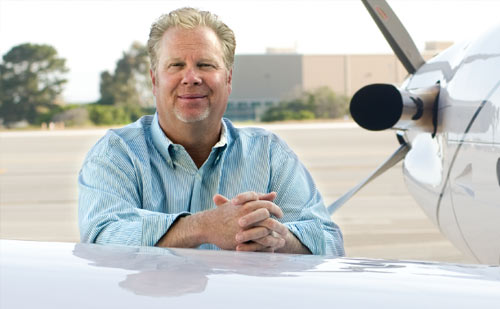
Days after a magnitude 7.0 earthquake devastated parts of Haiti, Carmel real estate developer Erik Pilegaard visited a facility filled with injured victims.
“Imagine a big open room, and the beds are all lined up next to each other. There are just tons of people in there. There’s a person with a crushed leg on one bed, and a person with a crushed pelvis and broken bladder on the next. Some people are still in shock, so one minute they’re OK and the next they kind of freak out,” he says. “Obviously, these were very, very harsh conditions, and the doctors and nurses were trying to make a better situation out of it.”
Pilegaard, president of Pacific Oak Development, Inc., spent a week supporting those relief efforts through the Pilatus Owners & Pilots Association (POPA). More than 40 of the organization’s members volunteered to fly their corporate and private single engine turboprop Pilatus PC-12s in and out of Haiti, carrying medical professionals, supplies, equipment and food to isolated areas.
Over six days, Pilegaard alone donated approximately $20,000 worth of time, fuel and equipment to transport some 12,000 pounds of supplies and nearly 30 doctors and nurses. He landed in Les Cayes and Cap-Haitien, two communities that were inundated with earthquake victims.
“There were a ton of supplies flying into Port-au-Prince, but the supplies weren’t reaching the outer areas,” he recalls.”Patients then left Port-au-Prince because they either couldn’t get care or they had been waiting for a long time, and these little clinics and hospitals were just getting slammed.”
POPA Executive Director Laura Mason posted assistance requests from aid organizations on her association’s Web site; members then responded directly to the organizations they could help. Some pilots flew for a day or two, while others donated several weekends or longer blocks of time.
The first-hand contact with victims motivated many participants.
“This is not just writing a check. These guys physically see that what they’re doing makes a difference,” Mason says.”They fly in with their airplanes fully loaded. They unload the equipment, the food, the water, whatever, and they see it all go directly to the people they’re helping.”
According to Pilegaard, generous cargo space and maneuverability make Pilatus PC-12s ideal for this sort of mission. The planes seat eight with executive seating or 11 with commuter, while removable seats and large cargo doors make it easy to load and unload supplies. A maximum operating altitude of 30,000 feet and the ability to land on short, uneven runways mean the planes are well suited for remote trips.
As he planned each day’s outing, Pilegaard drew on past experience as a military medevac helicopter pilot. His passengers were doctors and nurses from as far as Texas, Tennessee, Minnesota and Florida, and donated supplies came from hospitals, universities and aid groups throughout the United States.
Once on the ground in Haiti, security officers and additional volunteers greeted Pilegaard’s plane. “We’d land, the United Nations would secure the aircraft and then a small group of Haitians would come in. Within ten minutes, they’d unload the aircraft and load trucks to distribute to various locations. It was very smooth,” he says.
Haitian volunteers and victims alike were extraordinarily appreciative for the assistance. “They were very, very pleased to see us—very grateful and very thankful. They appreciated us so much, because nobody else could actually get in there and deliver the goods. The combination of food, supplies and medical help, it was huge,” says Pilegaard.
Also huge was the trip’s personal impact for him. “My mom had passed away in November, 2009, so I was kind of feeling down and depressed,” he says. “You can dwell on that forever. But what helped me most was giving to others who were in desperate need. You forget about yourself. You’re not thinking about how you feel, because you’re doing something that obviously is bigger than you are…it helped me heal.”
While on the ground in Haiti, Pilegaard worked closely with Bahamas Habitat. To support the organization’s earthquake relief efforts, visit www.bahamashabitat.org.
Salinas Business Supports Haitian Artists
“I want to thank you for the money you sent me for the damage caused by the earthquake that recently devastated our beloved country, Haiti,” says a note from Brutal Michel, after a January 2010 earthquake struck his community.
This is one of many thank you letters Haitian artists have sent Casey Riddell, who sells their creations through her Beyond Borders wholesale business and It’s Cactus folk art store in Salinas. After the disaster, Riddell began donating 100 percent of sale proceeds from a selection of Haitian metal artwork to hard-hit families.
“We just gave everything directly to Haiti,” she says. “When the earthquake happened, we were able to send money within three days. It went directly into our artists’ pockets just when they needed it most.”
Riddell is a Fair Trade Federation member who represents nearly 60 Haitian artists and their employees. They create pieces by using hammers and nails to shape metal repurposed from empty oil drums; she’s gotten their work into 1,500 shops since 1992. Riddell visits Haiti up to eight times a year, and she talks with her artists daily.
“One asked if he could have $1,100 worth of work to rebuild his house. So we did it,” she says. “I hear thank you, after thank you…they say it’s so nice to know that they’re not forgotten.”
Since January, Beyond Borders and It’s Cactus have given more than $20,000 from sales and donations to Haitian artists. Even with that, the recovery process is a slow one. “They all lost their homes or had severe damage,” Riddell says. “Everyone lost a family member or a close friend. There are problems with food and land. There are no schools. Jails collapsed, so criminals escaped. Everything has been affected.”
For more information, visit www.itscactus.com or call 831/998-8993.
—Renee Brincks